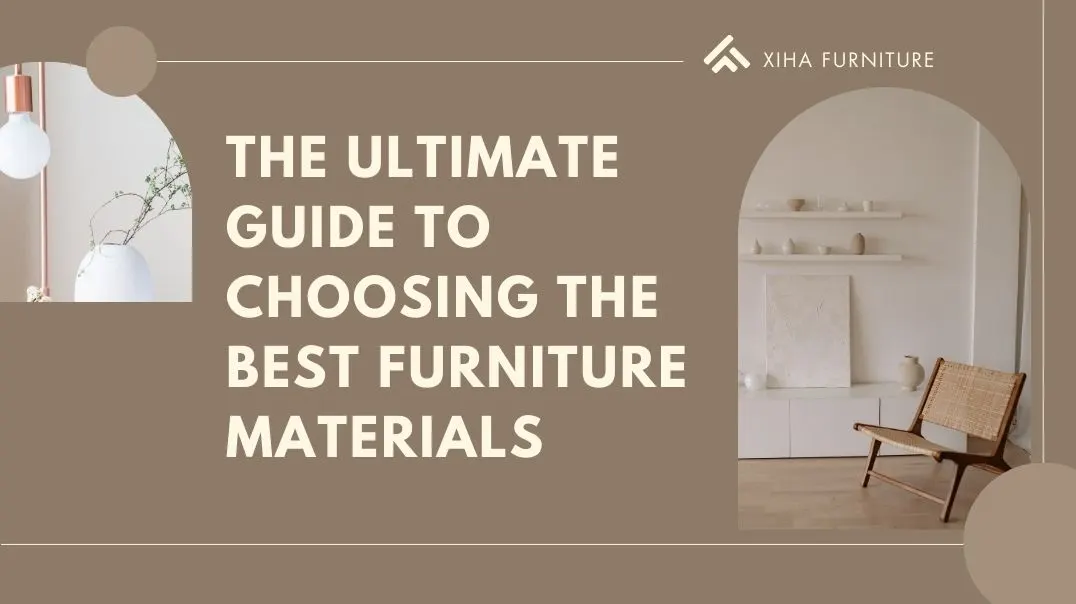Are you overwhelmed by the wide variety of Furniture Materials available today? Unsure whether wood, metal, plastic, or glass fits best in your home? Which materials last longer, look better, and make cleaning easier?
Furniture Materials are the foundation of every piece of furniture, determining how it looks, performs, lasts, and fits into your lifestyle. High-quality materials can enhance comfort, increase durability, and even improve the safety and sustainability of your living space. From solid wood that brings warmth and strength to modern engineered boards that offer cost-efficiency, every material serves a different purpose. Knowing the right Furniture Materials helps you invest smarter and avoid replacements.
If you want furniture that fits your lifestyle, not just your budget, this guide to Furniture Materials will help you avoid common mistakes and create a lasting home.
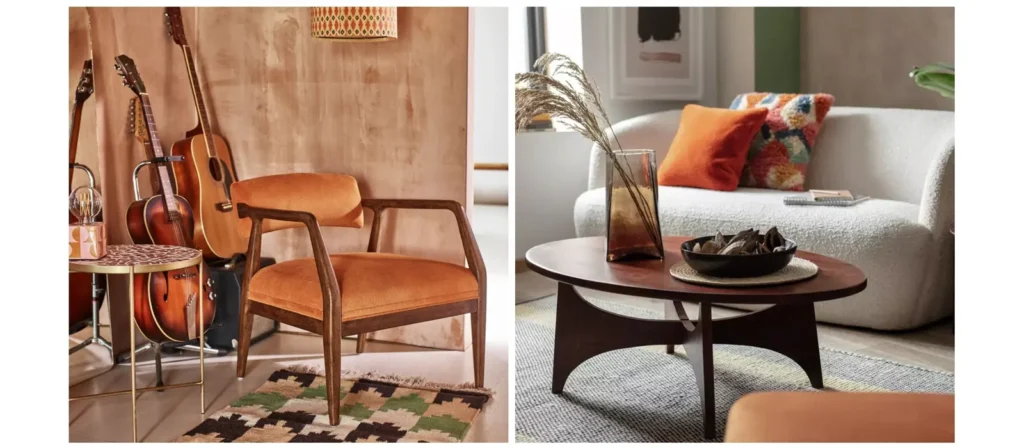
Importance of Choosing the Right Furniture Materials
When furnishing your home or office, the material of your furniture plays a pivotal role in its comfort, durability, and visual appeal. The wrong choice can lead to frequent repairs, quick wear-and-tear, and health or environmental concerns. Whether looking for a minimalist aesthetic, timeless elegance, or sustainable solutions, understanding furniture materials is your first step toward making smarter decisions.
Choosing the right material ensures longevity and compatibility with your lifestyle. Families with pets or children may prefer scratch-resistant surfaces, while those with a taste for luxury might opt for leather or natural stone. Budget-conscious buyers may lean toward engineered wood or plastic. The selection sets the tone for your space’s functionality, upkeep, and visual harmony.
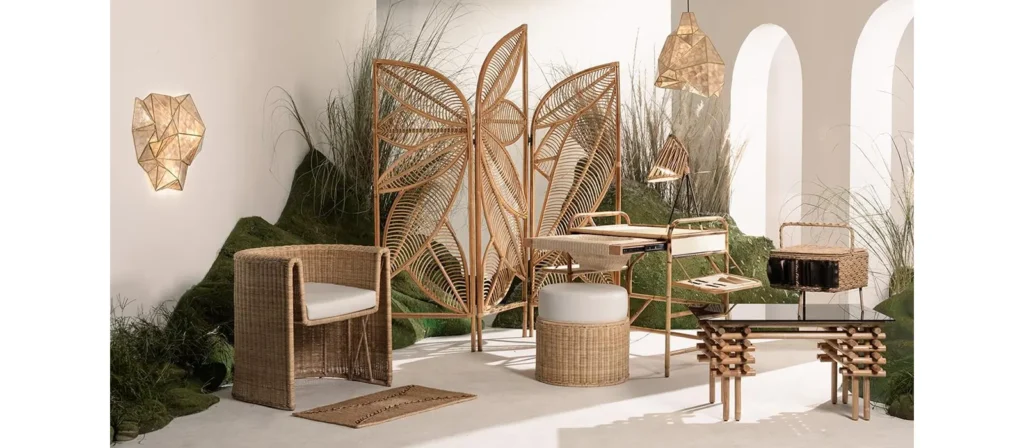
What are Eco-Friendly and Sustainable Furniture Materials?
Eco-friendly and sustainable furniture materials are sourced, manufactured, and used in ways that reduce environmental harm. These materials typically require less energy, create minimal waste, and are biodegradable or recyclable at the end of their life cycle.
Such materials often come with certifications like FSC (Forest Stewardship Council) or GREENGUARD, ensuring they meet rigorous sustainability standards. In today’s conscious consumer climate, choosing sustainable materials is not only responsible but also increasingly popular and stylish.
Examples of sustainable furniture materials include:
- Bamboo – A fast-growing, renewable resource that’s stronger than many hardwoods.
- Reclaimed Wood – Salvaged from old buildings, this prevents new tree cutting.
- Recycled Metal – Durable and fully recyclable, often used in frames or accents.
- Natural Latex Foam – Used in cushions and mattresses; biodegradable and toxin-free.
- Organic Cotton or Hemp – Grown without harmful pesticides, ideal for upholstery.
Sustainability goes beyond the material itself. It also considers how it’s processed. Non-toxic glues, low-VOC finishes, and local sourcing all contribute to a genuinely sustainable piece of furniture.
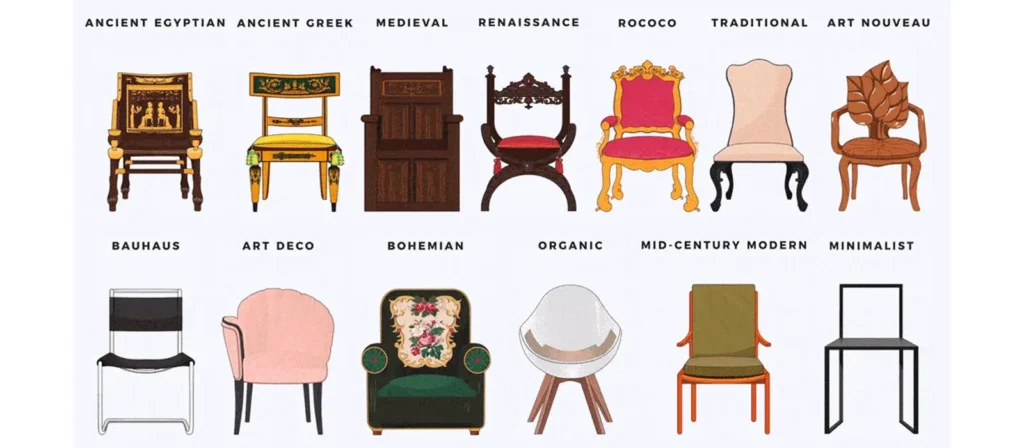
Evolution of Furniture Design
Historical Background
Furniture design has always been closely tied to the materials available in a given time and place. In ancient Egypt, furniture was built from hardwoods like ebony and acacia, showcasing hand-carved details and high craftsmanship. In medieval Europe, oak was widely used for its local abundance and resilience.
During the Industrial Revolution, furniture production changed dramatically. New materials like cast iron, molded plywood, and tubular steel became popular. This not only lowered the cost of production but also introduced bold new styles.
By the mid-20th century, designers like Charles and Ray Eames revolutionized furniture by blending aesthetics with functionality, using molded plastic and bent plywood. Their choices were driven not just by form but also by material innovation.
Modern Trends
Today’s furniture design emphasizes modularity, sustainability, and smart integration. Materials are chosen for both environmental impact and performance. For instance:
- Designers now favor FSC-certified woods and recycled metals.
- Upholstery leans toward organic fabrics or leather alternatives.
- Smart furniture integrates electronics while hiding cables inside eco-conscious shells.
10 Common Furniture Materials
Understanding the wide range of furniture materials available today is crucial to choosing the right product for your lifestyle, taste, and environment. Each material offers unique characteristics that influence its appearance, cost, longevity, and functionality.
1. Wood Furniture Materials
Wood has endured as a primary furniture material, prized for its warmth, durability, and natural aesthetic. Whether carved, veneered, or crafted from solid planks, wooden furniture remains a staple in homes and offices worldwide.
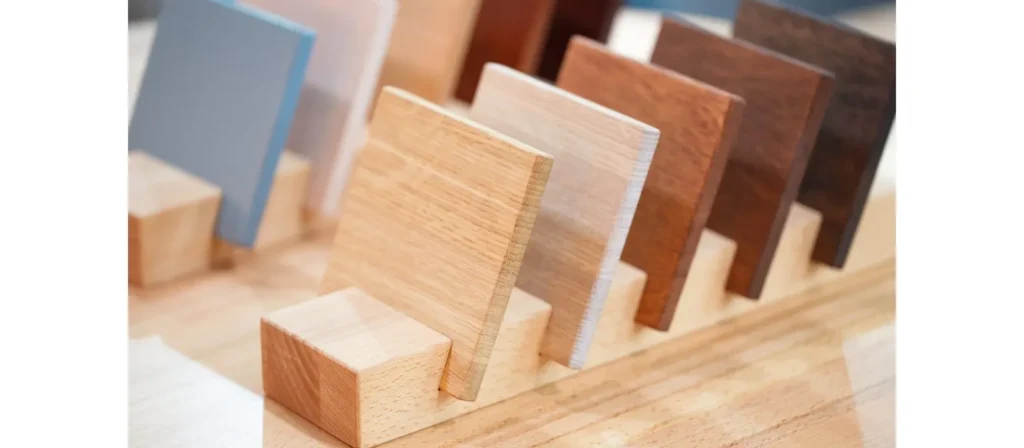
Types:
- Hardwood: Sourced from deciduous trees like oak, maple, walnut, teak, and mahogany. These are dense, durable, and resistant to wear.
- Softwood: Derived from coniferous trees such as pine, cedar, and fir. These are lighter, easier to work with, and typically more affordable.
- Reclaimed Wood: Salvaged from old buildings, barns, or shipping pallets, this is an eco-friendly option with a vintage appeal.
- Engineered Wood (e.g., plywood): Though technically distinct, some engineered woods are included in the wood category when veneered or used as core material.
Advantages:
- Aesthetically versatile with unique grains and finishes
- Highly durable, especially hardwoods
- Can be refinished, painted, or repaired
- Adds natural warmth and character to interiors
- Available in sustainable, eco-friendly forms (FSC-certified)
Disadvantages:
- Prone to scratches, moisture damage, and warping without proper treatment
- Typically heavier and more expensive than synthetic materials
- Requires regular maintenance (dusting, polishing)
- Can attract pests like termites if untreated
Lifespan:
High-quality solid wood furniture can last 25 to 100+ years with proper care.
Best Used For:
Dining tables, bed frames, bookshelves, cabinets, dressers, desks
Ideal use cases:
Wood is best suited for high-value or statement furniture in living rooms, bedrooms, and formal dining areas. It’s a preferred choice in both classic and contemporary interior themes where longevity and craftsmanship are valued.
2. Metal Furniture Materials
Metal is a versatile, industrial-strength material that has become increasingly popular in indoor and outdoor furniture. From lightweight aluminum chairs to heavy wrought iron bed frames, metal provides a sleek, modern, and durable option for furniture design. It is also one of the most sustainable materials, 100% recyclable without losing integrity.
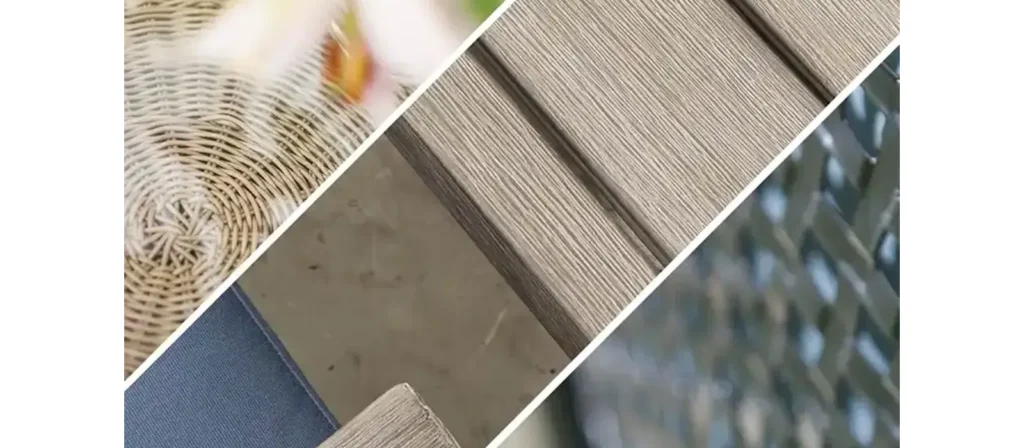
Types:
- Steel: Common in both frames and detailing, especially powder-coated for rust resistance.
- Aluminum: Lightweight, rust-resistant, often used in outdoor or portable furniture.
- Wrought Iron: Heavy, strong, and ideal for ornate traditional designs, though prone to rust.
- Brass and Copper: Mostly decorative due to their elegant, rich patinas and warm tones.
- Stainless Steel: Highly corrosion-resistant, used in high-traffic or commercial settings.
Advantages:
- Incredibly strong and durable
- Low maintenance; easy to clean
- Modern, minimalist, and industrial aesthetics
- Pest-proof and non-flammable
- Recyclable and environmentally friendly
Disadvantages:
- Can be prone to rust or corrosion if not treated properly
- Generally cold to the touch and may require cushions
- May dent or scratch under high pressure
- Heavy and sometimes more expensive depending on the metal type
Lifespan:
Well-maintained metal furniture can last 20–50 years or more.
Best Used For:
Bar stools, bed frames, patio furniture, office chairs, dining chairs, storage racks
Ideal Settings:
Industrial lofts, modern interiors, outdoor patios, minimalist spaces, urban apartments
3. Plastic Furniture Materials
Plastic is a highly adaptable and affordable furniture material that has evolved far beyond its disposable stereotype. With advancements in polymer engineering, today’s plastics are more durable, attractive, and sustainable than ever before. They can be molded into complex shapes, colored in any hue, and used indoors or outdoors.
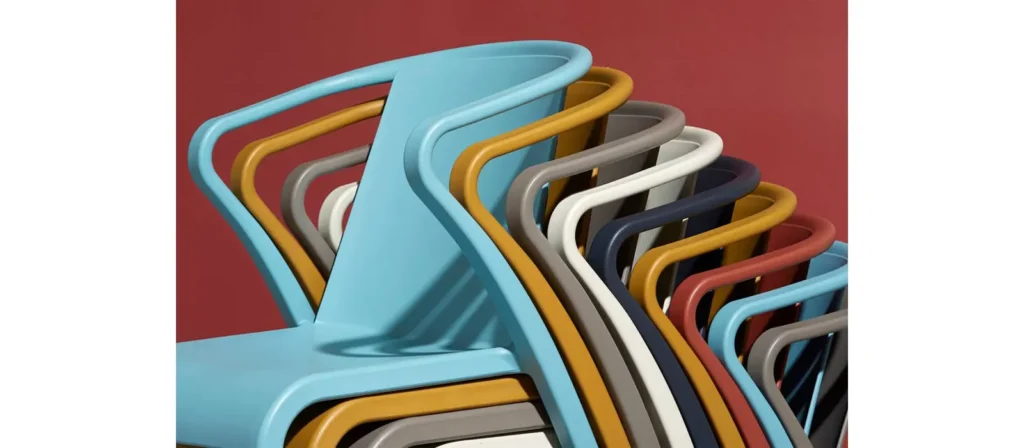
Types:
- Polypropylene (PP): Commonly used due to its flexibility and impact resistance.
- Polyethylene (PE): Frequently found in molded outdoor furniture.
- Acrylic (PMMA): A clear, glass-like plastic used in modern decor.
- Recycled Plastic Composites: Sustainable options from consumer waste like bottles or packaging.
- ABS Plastic: Durable and impact-resistant, used in mid-century style chairs.
Advantages:
- Lightweight and easy to move or rearrange
- Resistant to moisture, corrosion, and most household chemicals
- Affordable and widely available
- Easy to clean and maintain
- Ideal for mass production in various shapes and colors
Disadvantages:
- Not as strong or durable as wood or metal
- Can fade or become brittle under direct sunlight
- May appear cheap or less premium
- Some plastics are not biodegradable and can be harmful to the environment if not recycled
Lifespan:
Depending on quality, 5–20 years. Recycled plastic furniture often lasts longer due to added reinforcements.
Best Used For:
Outdoor seating, stackable chairs, children’s furniture, modular storage units
Ideal Settings:
Plastic is ideal for outdoor spaces, kids’ rooms, or homes seeking affordable, low-maintenance solutions. It’s also useful in creative, modern interiors where bold colors or shapes are desired.
4. Glass Furniture Materials
Glass in furniture design evokes sophistication, lightness, and a clean, modern aesthetic. It’s often used as a secondary or complementary material in tabletops, shelves, and display cases. Thanks to manufacturing advancements like tempering and lamination, glass is stronger and safer, making it more viable for residential and commercial use.
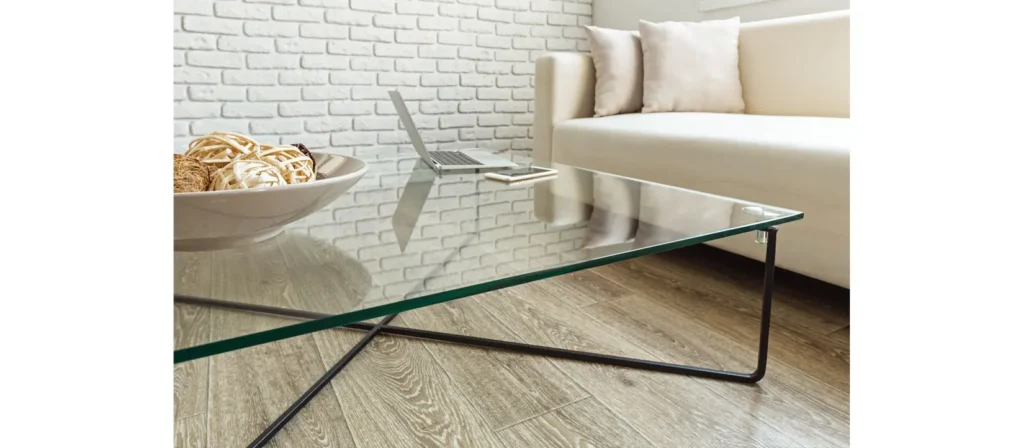
Types:
- Tempered Glass: Heat-treated for strength and safety. Shatters into small, blunt pieces if broken.
- Frosted Glass: Acid-etched or sandblasted for privacy and a soft, matte look.
- Tinted Glass: Colored to reduce glare and UV light, offering visual interest and shading.
- Laminated Glass: Two or more glass layers with a plastic interlayer to hold shards if shattered.
Advantages:
- Visually expands space and allows light to pass through
- Non-porous and easy to clean
- Heat and stain-resistant
- Works well with metal or wood for hybrid designs
- Adds elegance and a modern feel
Disadvantages:
- Fragile, especially if untreated or low-quality
- Easily shows fingerprints, smudges, and dust
- Sharp edges can be dangerous without beveling
- Less warm or tactile than natural materials
Lifespan:
10–20 years, depending on use and thickness; longer if tempered and handled carefully.
Best Used For:
Coffee tables, dining tables, shelving units, office desks, cabinet doors
Ideal Settings:
Glass is ideal in small apartments, modern or luxury interiors, and minimalist spaces where visual clarity and elegance are desired. It is also a great choice in rooms that benefit from reflected light or transparency.
5. Rattan and Bamboo Furniture Materials
Rattan and bamboo are sustainable, flexible, and stylish materials popular for eco-friendly and artisanal furniture. Often mistaken as interchangeable, they are structurally and visually distinct: rattan is a vine from tropical forests, while bamboo is a woody grass. Both materials are praised for their organic aesthetics and lightweight structure.
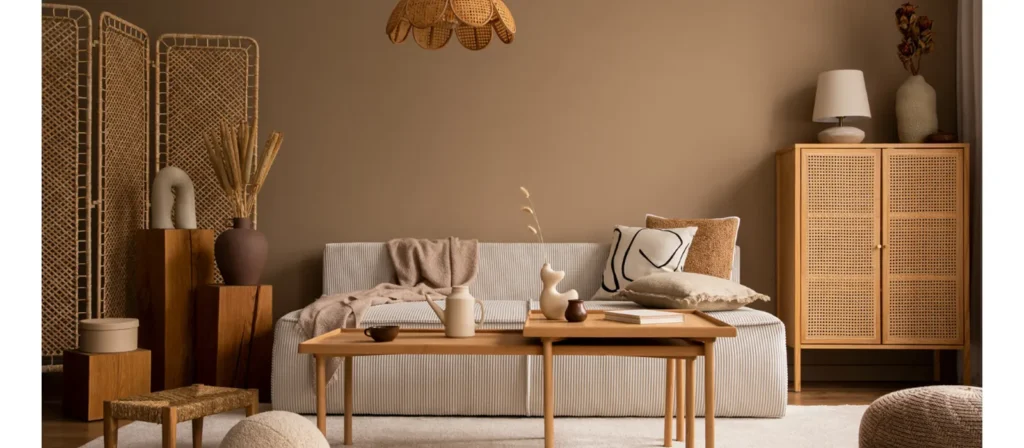
Types:
- Natural Rattan: Malleable, used for weaving furniture and decor.
- Synthetic Rattan (Resin Wicker): Weather-resistant plastic resembling natural outdoor rattan.
- Solid Bamboo: Cut and laminated for structural applications.
- Woven Bamboo: Used in screens and decorative accents.
Advantages:
- Renewable and eco-friendly
- Lightweight and easy to move
- Adds texture and warmth to interiors
- Offers a casual, relaxed look
- Affordable and widely available
Disadvantages:
- Natural rattan is not water-resistant unless treated
- Can crack or unravel over time with rough use
- Sensitive to high humidity and temperature changes
- Less supportive than metal or hardwood options
Lifespan:
5–15 years for natural materials; up to 20 years for synthetic rattan with proper care
Best Used For:
Accent chairs, lounge sets, baskets, side tables, patio sets
Ideal Settings:
Perfect for bohemian, coastal, or eco-conscious interiors. Rattan suits casual or relaxed environments like sunrooms or patios, while bamboo brings modern sustainability to bedrooms or small-space furniture.
6. Medium Density Fiberboard (MDF)
MDF is an engineered wood product that compresses wood fibers with resin under heat and pressure. It provides a smooth, uniform surface ideal for painted or laminated finishes. MDF is extensively used in mass-produced furniture as a cost-effective alternative to solid wood.
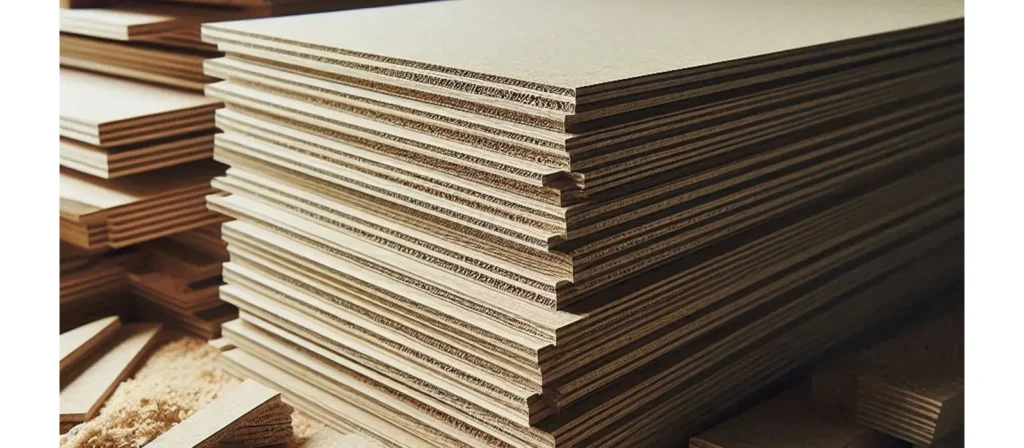
Types:
- Standard MDF: Used in low-moisture, indoor environments.
- Moisture-Resistant MDF (MR-MDF): Green core suited for kitchens and bathrooms.
- Fire-Retardant MDF (FR-MDF): Red core used in commercial or safety-conscious settings.
Advantages:
- Very affordable
- Uniform texture, no grain or knots
- Excellent surface for painting and veneering
- Easily machined and customized
- More stable than solid wood in fluctuating humidity
Disadvantages:
- Not as durable or strong as hardwood
- Susceptible to water damage if not sealed properly
- Can sag under heavy weight
- Difficult to repair if chipped or dented
- May emit formaldehyde if not certified low-VOC
Lifespan:
5–10 years under normal use; longer if well-maintained and kept dry
Best Used For:
Wardrobes, shelves, media consoles, flat-pack furniture, interior panels
Ideal Settings:
MDF is commonly found in modern and minimalist designs, as well as budget-conscious furniture pieces. It’s best for indoor environments where moisture is controlled, such as bedrooms, offices, or dry kitchens.
7. Marble Furniture Materials
Marble is synonymous with luxury, elegance, and timelessness. Used for centuries in architecture and furniture, it adds grandeur to any interior. Though traditionally associated with countertops and flooring, marble is now popular for coffee tables, side tables, and dining surfaces, offering a striking visual impact.
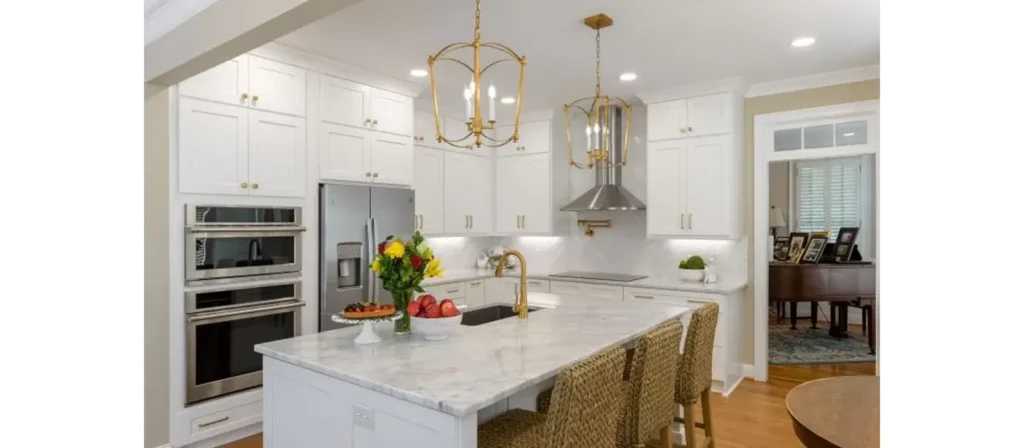
Types:
- Natural Marble: Includes varieties like Carrara (white-gray), Calacatta (bold veins), and Nero Marquina (black).
- Cultured Marble: Engineered marble mixed with resin; more uniform and cost-effective.
- Composite Marble: Crushed marble mixed with cement or polymer resin for durability.
Advantages:
- Extremely durable under normal use
- Heat-resistant—ideal for kitchen and dining areas
- Each slab has unique patterns, adding individuality
- Low maintenance when properly sealed
- Adds resale value and aesthetic prestige
Disadvantages:
- Expensive to purchase and install
- Can stain easily if unsealed (e.g., wine, coffee, acidic substances)
- Prone to chipping along edges
- Very heavy, requiring sturdy support
- Cold to the touch and not ideal for comfort-focused surfaces
Lifespan:
20–50+ years; possibly a lifetime with proper sealing and minimal impact damage
Best Used For:
Tabletops, vanity counters, accent surfaces, fireplace mantels
Ideal Settings:
Marble fits beautifully in luxury homes, boutique interiors, and any space where opulence is valued—especially in kitchens, bathrooms, and formal living or dining rooms. It’s perfect for statement pieces rather than everyday use surfaces.
8. Cloth Furniture Materials
Cloth or fabric is a foundational material in upholstered furniture, directly impacting comfort, appearance, and tactile experience. From natural weaves to synthetic fibers, fabric upholstery adds warmth and personality to sofas, chairs, and headboards.
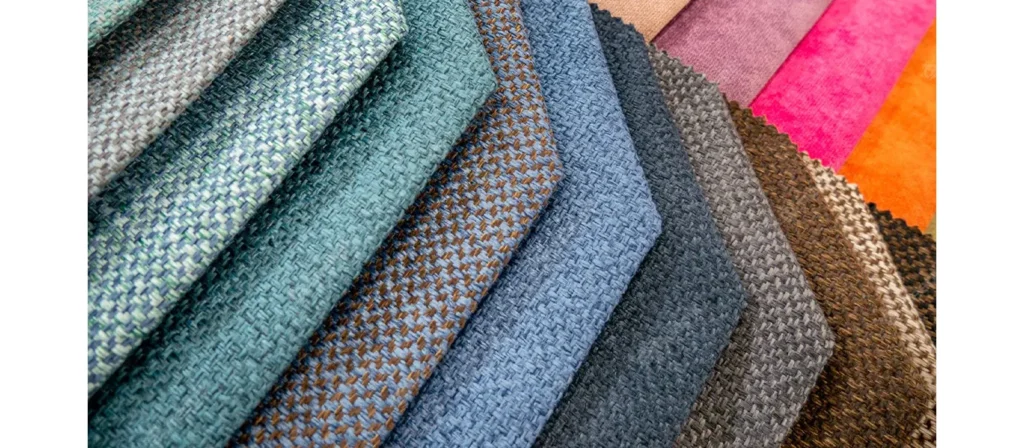
Types:
- Cotton: Soft, breathable, and natural—great for casual use
- Linen: Crisp and elegant with a natural look
- Velvet: Plush and rich, adds drama and luxury
- Polyester: Durable and often blended with other fibers
- Microfiber: Synthetic suede-like fabric, stain-resistant and soft
- Chenille: Textured and inviting, ideal for cozy environments
Advantages:
- Wide range of textures, colors, and patterns
- Breathable and comfortable for prolonged use
- Fabric covers can often be removed and washed
- Warmer and softer than leather or wood
- Great for layering with cushions and throws
Disadvantages:
- Stains more easily than leather or plastic
- Can fade over time with sunlight exposure
- Prone to wear and tear with heavy use
- Requires vacuuming or steam cleaning
- Natural fabrics can shrink or wrinkle if not cared for properly
Lifespan:
5–15 years, depending on fabric quality, usage, and maintenance routines
Best Used For:
Sofas, armchairs, ottomans, cushions, dining chairs
Ideal Settings:
Cloth is ideal in living rooms, family areas, and bedrooms where comfort is essential. It supports layered, cozy interiors and offers flexibility for updating the look through slipcovers or reupholstery.
9. Leather Furniture Materials
Leather has long been associated with luxury, masculinity, and durability. As an upholstery choice, it offers unparalleled sophistication and comfort. Available in various grades and finishes, leather suits classic and contemporary spaces and is prized for its longevity and ability to develop a beautiful patina over time.
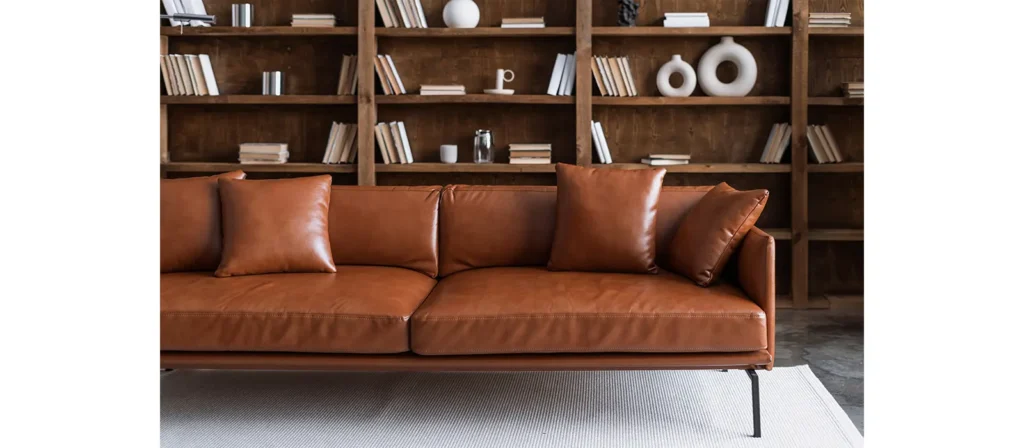
Types:
- Full-Grain Leather: Highest quality, with a natural surface and maximum durability
- Top-Grain Leather: Slightly sanded for uniformity, still very high-end
- Split-Grain Leather: Derived from the lower layers of hide—less durable, often embossed
- Bonded Leather: Made from leftover scraps and synthetic binders—budget-friendly but less authentic
- Faux Leather (PU or PVC): Man-made, cruelty-free alternative with a similar appearance
Advantages:
- Extremely durable and long-lasting
- Easy to wipe clean—resists most spills and dirt
- Hypoallergenic (does not trap allergens like fabric)
- Ages gracefully, developing a soft sheen (patina)
- Offers a premium look and feel
Disadvantages:
- Expensive, especially for high-grade types
- Sensitive to heat, sunlight, and moisture—can crack or fade
- Cold to the touch in winter
- Requires occasional conditioning to prevent drying
- Limited variety in colors and patterns compared to fabric
Lifespan:
15–25 years for top-quality leather; less for bonded or faux versions
Best Used For:
Sofas, recliners, executive chairs, bar stools, car seats
Ideal Settings:
Leather is ideal in executive offices, masculine or vintage interiors, and formal living areas. It’s also a great choice in homes that value easy maintenance without sacrificing luxury or style.
10. Mixed Materials
Mixed materials in furniture design involve combining two or more distinct materials—such as wood, metal, glass, or fabric—into a single piece. This trend is driven by aesthetics and functionality, allowing designers to capitalize on different substances’ strengths and visual contrasts. Fusing organic and industrial elements gives furniture a unique, layered personality that fits various interior styles.
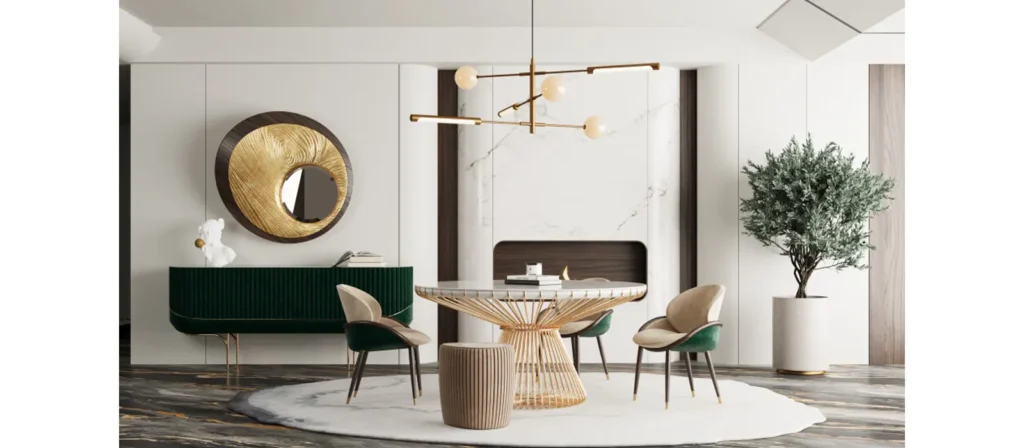
Types:
- Wood + Metal: Popular for dining tables and shelving units, combining warmth and strength
- Glass + Steel: Common in office desks and modern coffee tables
- Marble + Brass: Found in luxurious side tables or console tops
- Fabric + Wood or Metal: Typical in chairs, sofas, and headboards
- Recycled + Natural Materials: Used in eco-conscious designs and bespoke furniture
Advantages:
- Offers greater design flexibility and innovation
- Enhances visual contrast and tactile interest
- Allows customization for specific use cases
- Balances aesthetic appeal with structural integrity
- Broadens compatibility with different design themes
Disadvantages:
- Differences in material behavior (expansion, wear rate) may affect longevity
- Maintenance can be complex, as each component may require different care methods
- Repairs are more challenging due to material integration
- Quality of craftsmanship greatly influences durability
Lifespan:
10–30+ years depending on the materials used and craftsmanship quality
Best Used For:
Coffee tables, dining tables, bookshelves, lighting fixtures, console tables
Ideal Settings:
Mixed materials are ideal in contemporary, eclectic, or industrial interiors where form and function intersect. They’re also popular in urban apartments and multifunctional spaces where visual interest is important without sacrificing practicality.
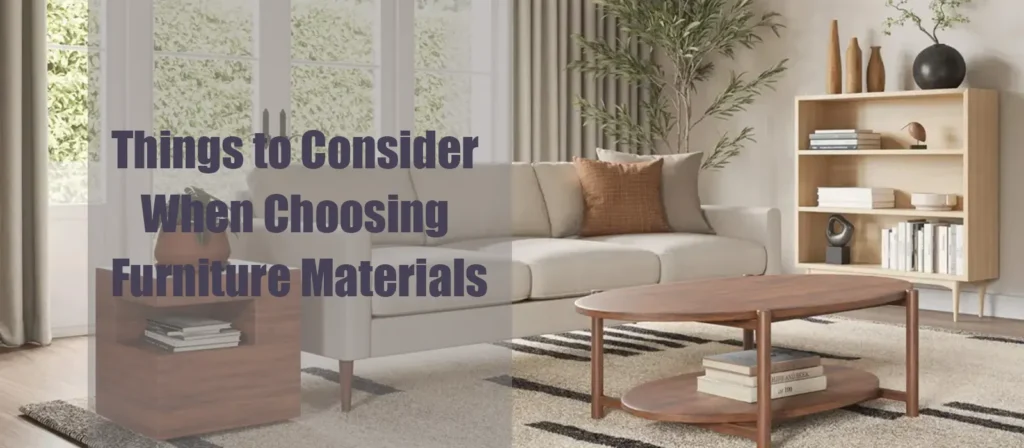
Things to Consider When Choosing Furniture Materials
Choosing the right furniture material is about more than just aesthetics. All factors should be carefully evaluated before purchasing, as they directly affect how practical the furniture will be and how long it will last in your space.
1. Safety
Toxic finishes, formaldehyde in particle boards, or sharp metal edges pose risks—especially in homes with kids or pets. Always opt for materials with safety certifications and rounded designs.
2. Durability
Not all materials are created equal. Durability depends on usage and placement. A couch in a high-traffic living room needs more robust materials than an occasional armchair in a guest room.
Choose materials based on stress tolerance:
- High Use: Solid hardwoods, metal frames
- Moderate Use: Engineered wood, treated rattan
- Low Use: Softwoods, plastics
3. Comfort
Materials like upholstered foam, memory foam, and soft fabrics add comfort. Avoid overly rigid materials unless you plan to pair them with cushions or padding.
4. Environmental Protection
Opt for certified materials:
- FSC (Forest Stewardship Council) wood
- GREENGUARD-certified foam
- OEKO-TEX textiles
Each certification guarantees lower emissions and better eco-practices. Whenever possible, ask your furniture maker about sourcing and processing.
5. Aesthetics
Materials have strong visual personalities:
- Wood adds warmth and tradition
- Metal feels modern and cool
- Glass exudes sophistication
- Fabric offers softness and color variety
6. Cost
Materials affect not just sticker price but lifecycle cost. Engineered wood may cost less now but could wear faster. Investing in high-quality, sustainable materials can reduce replacement costs and boost resale value.
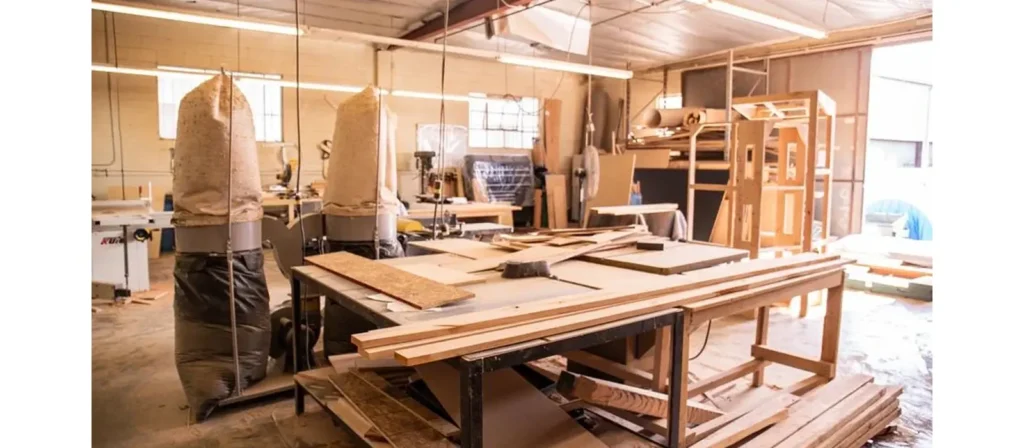
Tips for Choosing the Best Furniture Materials
- Define Usage Needs First: Is this for daily use, occasional decor, or outdoor exposure? Let functionality lead your material decision.
- Match Materials to Climate: Humidity can warp wood; dry heat may crack leather.
- Choose Multi-Functional Materials: Look for those that blend strength, aesthetics, and sustainability.
- Consider Long-Term Value: Consider warranty, maintenance, and aging characteristics.
- Test Before Buying: Feel the texture, assess weight, and evaluate comfort.
- Read Certifications Carefully: Not all “green” labels are equal—opt for globally recognized eco-certifications.
- Mix, don’t match: It’s okay to blend materials. For instance, a metal frame with a wooden top offers strength and warmth.
How to Distinguish Between Medium Density Fiberboard, Particle Board and Solid Wood?
| Feature | Solid Wood | Medium Density Fiberboard (MDF) | Particle Board |
|---|---|---|---|
| Composition | Natural wood cut from trees | Wood fibers bonded with resin | Wood chips and shavings with resin |
| Strength | Very strong and durable | Moderate strength | Low strength |
| Moisture Resistance | High (depends on type) | Moderate (swells if soaked) | Low (swells easily) |
| Surface Finish | Natural grain, can be stained | Smooth surface, best for paint | Rough, often needs laminate |
| Weight | Heavy | Heavier than particle board | Light |
| Cost | Most expensive | Mid-range | Least expensive |
| Eco-Friendliness | Renewable (if FSC certified) | Uses recycled fibers | Often uses waste materials |
| Common Uses | High-end furniture, heirlooms | Cabinetry, interior furniture | Budget furniture, shelving |
How to Match Furniture Materials with Interior Design?
Matching furniture materials with your interior design is both an art and a science. The material should complement the room’s style, texture, and mood while supporting the intended function. Here’s how different materials pair with popular interior styles:
- Modern/Minimalist:
This style thrives on clean lines and simplicity. Use materials like metal, glass, and high-gloss finishes. Matte black steel paired with clear or frosted glass enhances the visual clarity of a modern space. - Traditional/Classical:
Opt for rich woods like mahogany, oak, and cherry. Leather also plays a strong role in classical living rooms or libraries. Carved wood furniture with natural upholstery works well here. - Scandinavian:
This style favors light wood, white surfaces, and natural textiles. Birch or ash wood paired with cotton or wool fabrics captures the airy, minimalist feel Scandinavians love. - Bohemian:
An eclectic style that loves organic textures. Rattan, bamboo, and woven cloth mix beautifully in relaxed, colorful spaces. Imperfections and mismatched textures add to the charm. - Industrial:
A warehouse-inspired aesthetic benefits from rugged furniture materials like reclaimed wood and raw steel. Exposed rivets, weathered textures, and distressed finishes fit perfectly here. - Rustic/Farmhouse:
Think of distressed wood, iron, and soft cotton or burlap fabrics. The goal is comfort with a sense of history. Warm-toned woods and aged finishes play a key role.
When you choose furniture materials that complement your interior design, your space will feel more intentional, balanced, and personalized.
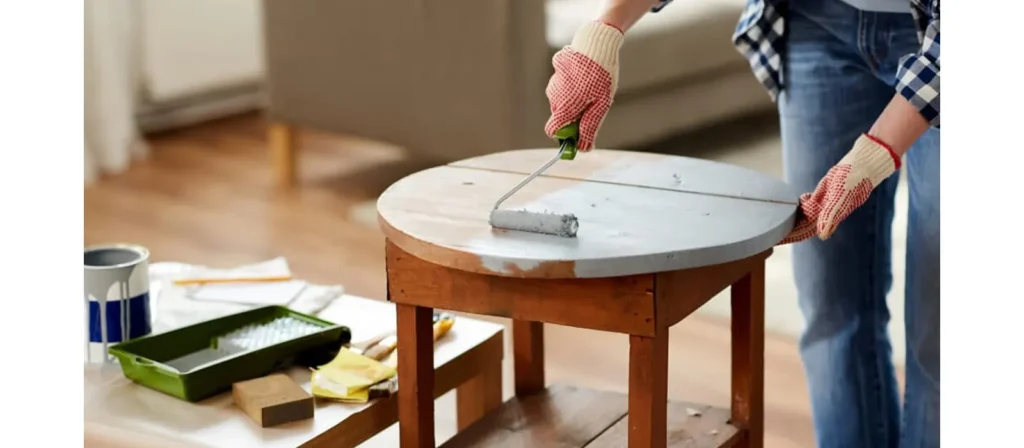
Upcycling and Recycling Furniture Materials
Upcycling
Upcycling transforms old furniture into something new and better without breaking it down. A vintage dresser might become a bathroom vanity, or a ladder might become a bookshelf. This creative reuse gives furniture a second life while adding a unique personality.
Upcycling is popular in sustainable design because it reduces waste and conserves resources. It’s also budget-friendly and often results in conversation pieces that mass-produced furniture can’t match.
Recycling Process
Recycling involves breaking furniture down to its raw materials—wood chips, plastic pellets, or metal sheets—and then reforming them into new materials. Engineered woods like MDF are often made this way. The challenge lies in separating mixed materials like metal screws embedded in plastic or glued laminates on particle boards.
Proper furniture recycling reduces landfill waste and supports the circular economy, in which nothing is wasted and everything is reused or reborn.
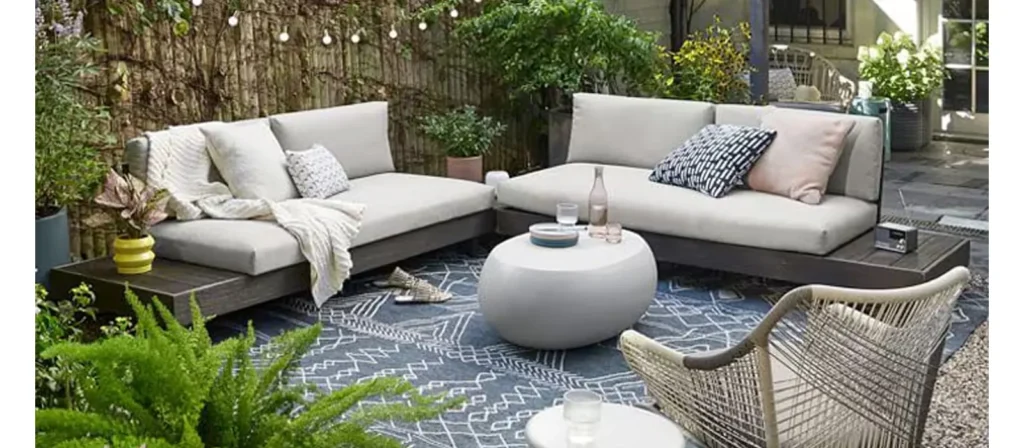
How to Choose the Best Material for Outdoor Furniture?
Outdoor furniture must be resilient against weather, UV rays, and temperature fluctuations. Here’s how different materials perform:
1. Metal Outdoor Furniture
Metals like aluminum, stainless steel, and wrought iron are common in outdoor settings due to their strength. Aluminum is rustproof and lightweight, making it easy to move. Stainless steel offers a sleek finish and durability. Wrought iron is strong but must be treated to resist rust.
Use powder-coated metals to extend life and prevent corrosion. Avoid unprotected iron in humid or coastal areas.
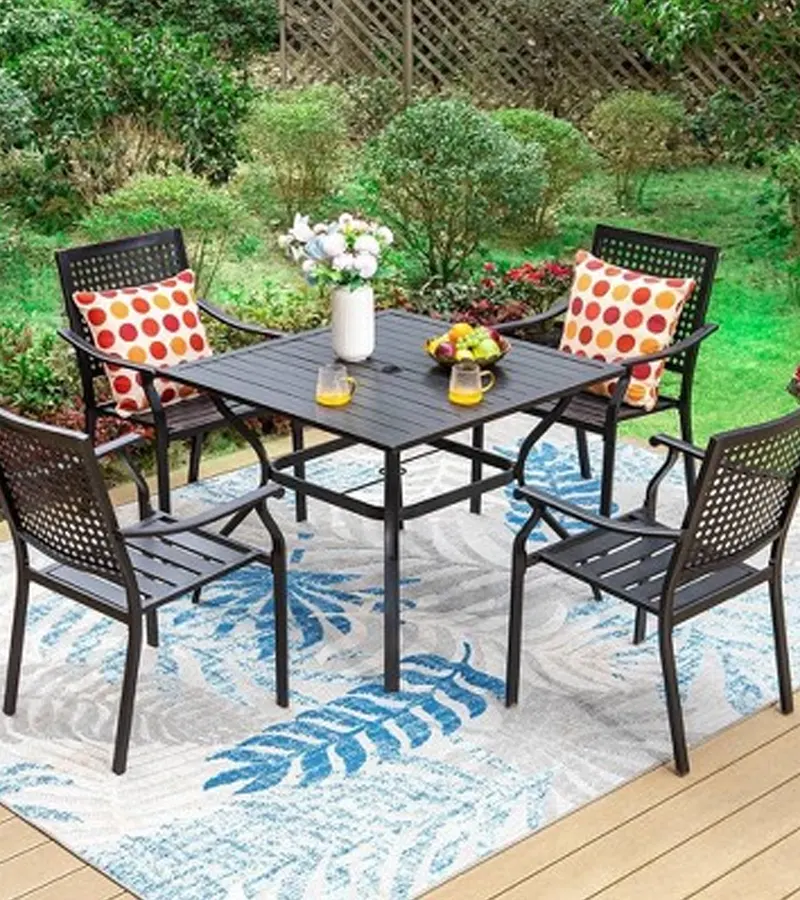
2. Wooden Outdoor Furniture
Teak, eucalyptus, and cedar are popular choices. Teak is naturally oily and highly weather-resistant, making it ideal for all climates. Eucalyptus is a more affordable alternative with similar resilience. Cedar resists insects and moisture but needs regular sealing.
Outdoor wooden furniture needs annual treatment with oils or sealants to maintain appearance and durability.
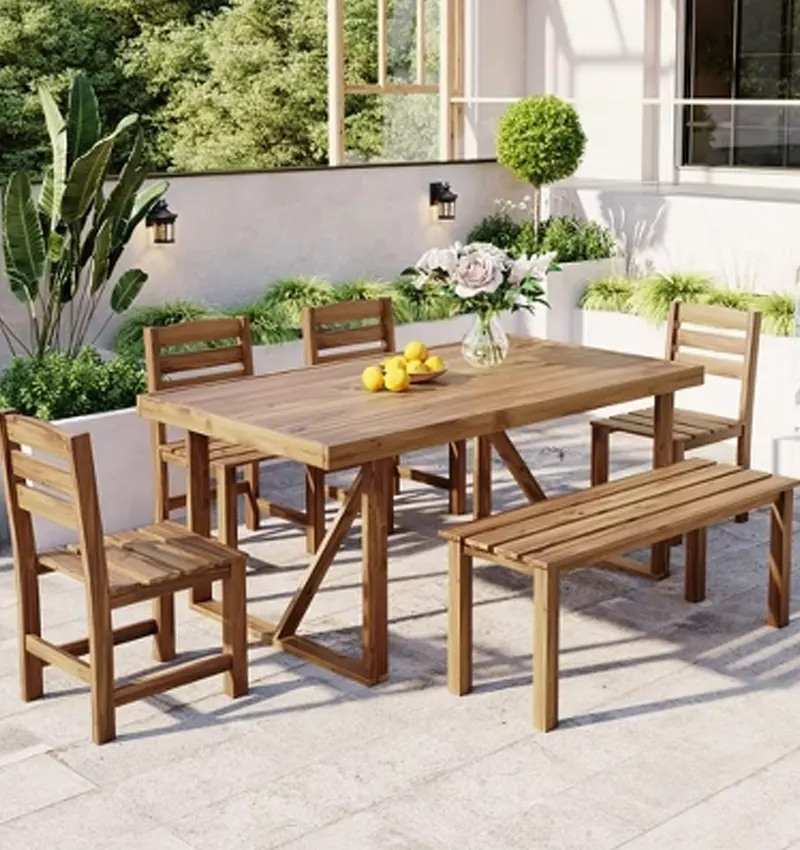
3. Wicker and Rattan Outdoor Furniture
Synthetic wicker made from resin is the most durable for outdoor use. It mimics the look of natural rattan but withstands rain, UV rays, and temperature swings.
Natural rattan is best kept indoors or in covered patios as it degrades quickly when exposed to the elements.
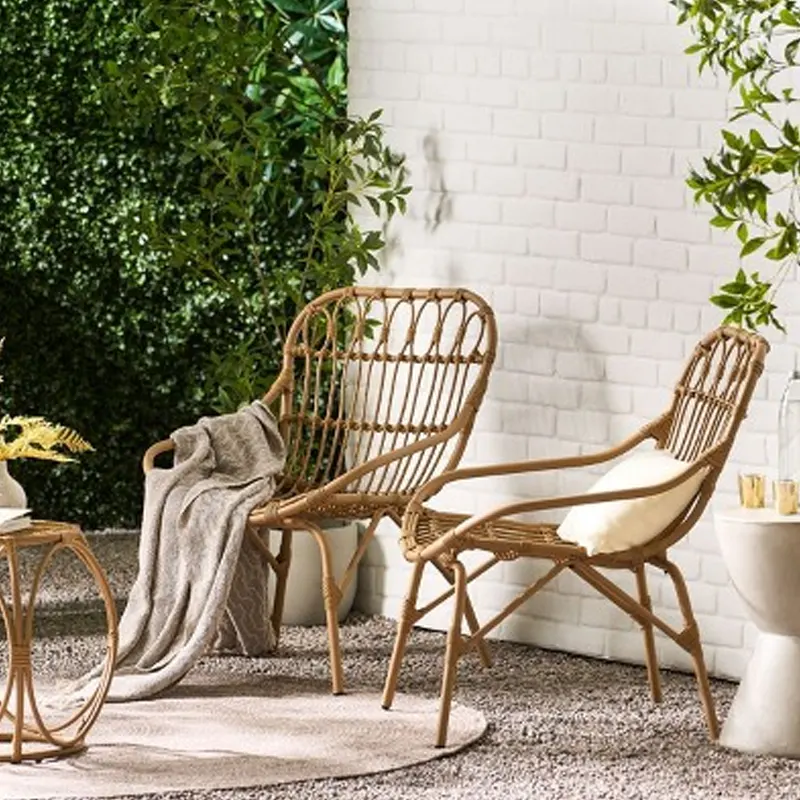
4. Plastic Outdoor Furniture
Plastic is lightweight, easy to clean, and resistant to moisture. High-density polyethylene (HDPE) is the most durable and UV-resistant type.
Avoid thin, cheap plastics—they crack and discolor over time. Recycled plastics are a more sustainable and environmentally friendly choice.
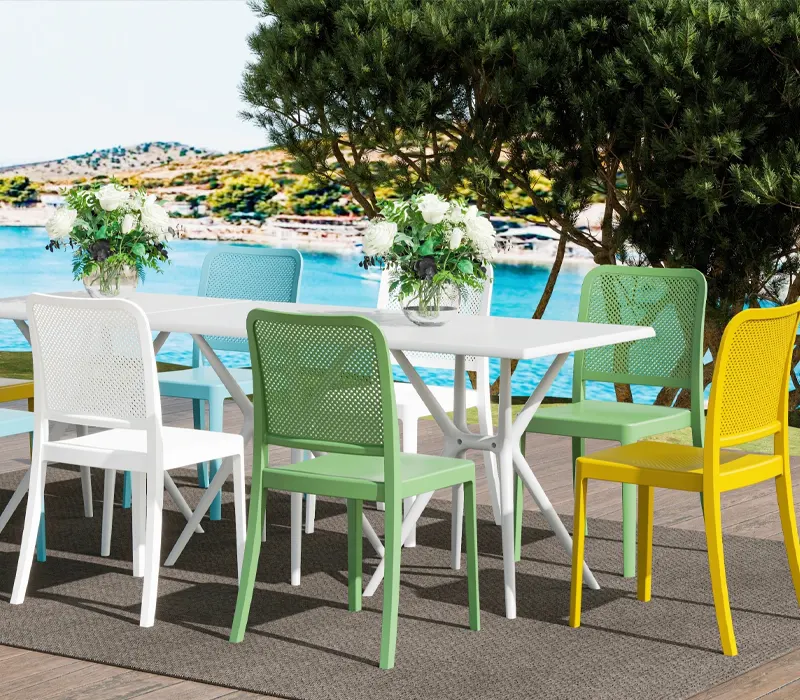
5. Outdoor Furniture Finishing Materials
Finishes like powder coating, marine-grade varnish, and UV-blocking sealants protect materials from wear and weathering. Cushions should be made from quick-dry foam and fade-resistant fabric such as Sunbrella.
These protective layers are essential for extending the life of outdoor furniture in harsh climates.
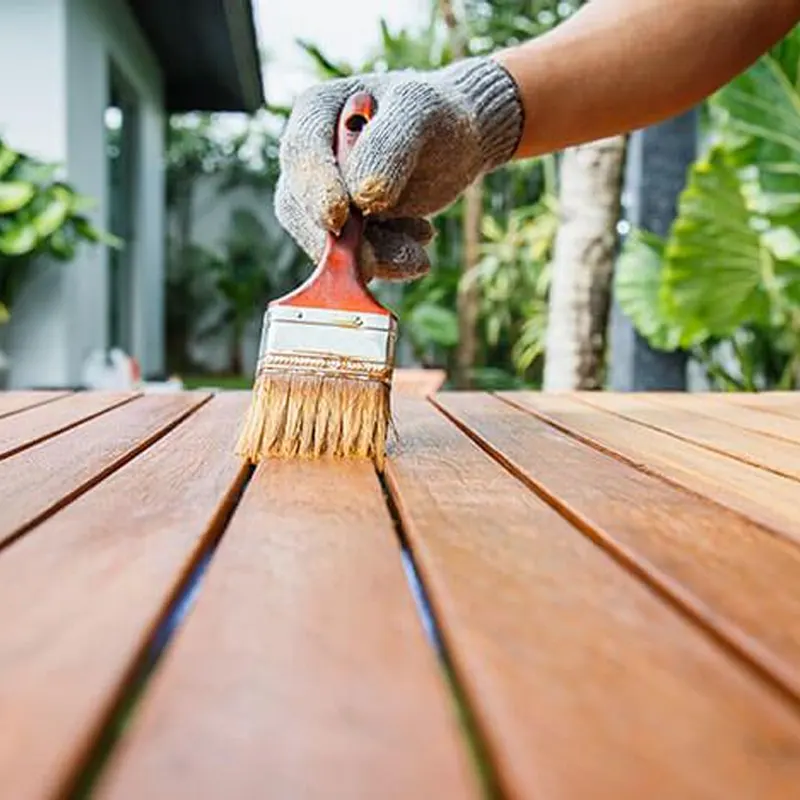
How Does Climate Affect Material Selection?
Climate is a crucial factor in choosing furniture materials. What holds up in one region might fail in another.
- High Humidity: Avoid softwoods and untreated metal; they warp or rust. Opt for teak, aluminum, or plastic.
- Dry Heat: Leather can crack; wood may shrink. Use treated wood and condition leather regularly.
- Coastal Areas: Salt air corrodes metal. Choose rustproof metals or marine-grade finishes.
- Cold & Snow: Freezing temperatures damage brittle plastics and unsealed wood. Store items indoors or use weather-resistant covers.
Always match your materials to climate conditions to prevent premature aging and ensure longevity.

Care Tips for Different Furniture Materials
Proper care prolongs the life and look of your furniture. Here’s a guide for maintenance by material type:
- Wood: Use mild cleaners, avoid direct sunlight, and apply wax or polish occasionally. Keep away from excessive moisture.
- Metal: Clean with a damp cloth and mild soap. Dry immediately to prevent rust. For outdoor metal, reapply protective coatings yearly.
- Plastic: Wipe down with soapy water. Avoid abrasive cleaners that may scratch the surface. Store indoors during extreme heat or cold.
- Glass: Use glass cleaner or vinegar solution. Avoid impacts and inspect regularly for chips.
- Fabric Upholstery: Vacuum regularly. Spot clean spills immediately with mild detergent. Professional cleaning every few months improves longevity.
- Leather: Wipe with a soft cloth. Use leather conditioner twice a year. Avoid direct heat and sunlight.
FAQs
- Are plastic furniture materials eco-friendly?
Modern recycled plastics offer sustainable options, though not all are environmentally sound. - Does fabric furniture get dirty easily?
Depends on the fabric—microfiber resists stains, while linen and velvet require careful maintenance. - Are synthetic furniture materials safe?
Yes, if properly certified. Look for materials that are free from VOCs and harmful chemicals. GREENGUARD or OEKO-TEX certifications ensure safety. - How do I identify high-quality wood furniture?
Check for weight, grain consistency, joinery (dovetail or mortise and tenon), and finish. Solid hardwood is generally heavier and more durable than engineered alternatives. - What is the lowest-maintenance material for furniture?
Plastic and metal are generally the easiest to maintain, requiring just basic cleaning and occasional checks for rust or cracks. - Is it worth investing in FSC-certified wood furniture?
Yes, FSC certification ensures the wood comes from responsibly managed forests, reducing deforestation and supporting sustainable practices. - How do I match furniture materials to my home’s color palette?
Warm tones pair well with woods like walnut and cherry, while cool tones match metals and light woods. Use swatches and mood boards to test combinations. - Does upcycled furniture last as long as new furniture?
If structurally sound and properly refurbished, upcycled furniture can be just as durable, sometimes even more so due to higher-quality original construction.
Conclusion
Choosing the right furniture materials is a cornerstone of smart interior design. Whether you’re drawn to the timeless warmth of wood, the sleekness of metal, or the innovation of composites, your selection should reflect your lifestyle, taste, and values. With sustainability and durability increasingly in focus, being informed about material options helps you create a space that’s both beautiful and built to last.

